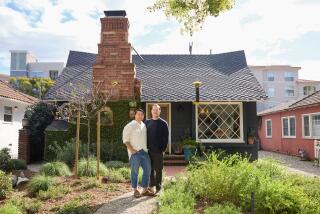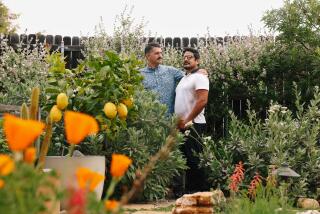Gardening : Their Passions for Bromeliads Deeply Rooted in Billbergia
Stan Oleson, a retired electronics engineer, has been filling his San Pedro back yard with exotic bromeliads for 20 years, ever since he first attended a bromeliad show at South Coast Botanic Garden.
He bought a Billbergia nutans “Queen’s Tears” that day, and he has been nurturing hundreds of its relatives (plus a few hundred unrelated plants) ever since. The yard is crammed, overflowing with hanging plants, plants in tiny pots or huge containers, “bonsai’d” plants, young starts and old specimens underfoot and overhead.
The rear of the yard is covered with shade cloth to protect the many long benches crowded with more plants. The patio, covered with a plastic roof, is the potting shed.
Slide Show Scheduled
Oleson is not alone in his plant passion: On Sunday, he will introduce Don Beadle, a Texas billbergia hybridizer, at the South Coast Botanic Garden, where Beadle will present a billbergia slide show as part of the Sunday in the Garden program series. Beadle, like Oleson, is a bromeliad hobbyist whose hobby became an obsession; in the past 12 years, Beadle has hybridized about 1,600 billbergias, “but very few worthwhile, only about 100,” he says.
Oleson too is a hybridizer, crossing varieties in an effort to breed brighter colored flowers and smaller plants, and like Beadle, he is modest about his accomplishments. He admits, after some prodding, that he will investigate ways to register his hybrid beauty, Billbergia nutans “Theodore Mead.”
Oleson attends about nine bromeliad shows a year, selling just enough of his plants “to buy another plant.” He and his wife, Val, are editor and co-editor, respectively, of the Inflorescence, the newsletter of the South Bay Bromeliad Associates, which dispenses useful information on the care and feeding of all kinds of bromeliads.
Billbergias have thick, often colorful, fleshy leaves that grow up and out, forming a cup from which the brilliant flowers--usually red, pink or orange, often combined with white or blue--emerge.
Plenty of Need
“Billbergias need plenty of light,” Oleson cautions, “but no direct sun through a window, and they need good air circulation.”
The cup in the center of the plant should always have water in it, “the cone-shaped growing tip is inside that cup; it’s the most tender part of the plant and if it dries out, the plant could die. When you fill the cup, let the water run down the sides of the leaves and into the soil, and give it enough so that water runs out the bottom of the container.”
Don’t worry about the roots, Oleson says. “They are insignificant, merely holding mechanisms so the water won’t fall out; the plants will grow on anything.”
Billbergias are epiphytes--plants that grow on air--but they also grow on trees, rocks or rich forest humus. Indoor gardeners should keep them in containers of very loose soil, Oleson says.
The plants are easily--but slowly--propagated by removing the suckers, called pups, that grow at the base of the parent plant. And don’t be alarmed if the glorious plant suddenly collapses one day; they all die after flowering. But they take many years to flower, and when they do, the blooms last several weeks (blooming season is generally October to February).
Excellent House Plants
Billbergias make excellent house plants and many can be grown outside in frost-free areas, where they will naturalize on trees, especially palms. One thing to remember when planting billbergias outside: the less sun, the less color in the plant. This may not be important with a plain green-leaved variety, but some billbergias ( Billbergia amoena “rubra,” for example) have beautifully colored leaves, and some varieties have leaves that are splashed, striped or streaked with different colors.
When Beadle arrives in Los Angeles for his slide program, he plans to spend some time in hot bromeliad pursuit: “The collectors in California have so many of them that are not available anyplace else,” he says. “I can look under bushes and behind trees, root around in the collections and find the ones that I don’t have.”
Beadle will bring 160 slides of blooming billbergias to the South Coast Botanic Garden program, which should last about 30 minutes, he says. His Corpus Christi, Tex., greenhouse--a 50x30-foot, two-story structure--”is full of bromeliads, all in hanging pots.”
Beadle has been photographing his plants in preparation for a book he intends to write on billbergias, and he is now taking the first tentative steps into mail order.
“It takes a long time to build a supply, because one cultivar can only reproduce itself twice a year. I usually get about six or eight pups off one plant over two or three years.” Beadle and other members of the International Bromeliad Society Inc. are anxious to devise a means of registering new hybrids so there will be some uniformity and consistency in varieties, especially the newer ones.
Sponsored by the South Coast Botanic Garden Foundation and the South Bay Bromeliad Associates, Don Beadle’s billbergia slide show will take place at 2 p.m. on Sunday at the South Coast Botanic Garden, Palos Verdes Peninsula . Admission to the garden is $3 for adults, $1.50 for students and seniors over 62; the billbergia program is free. Billbergias and other bromeliads will be on display and for sale before and after the program.






